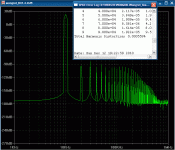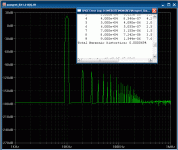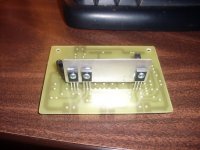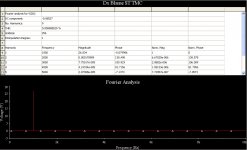Split off from the thread "Bob Cordells power amplifier book" , this thread will deal with the history , theory , applications ,and simulations associated with the latest , greatest... "devastatingly effective" little trick to grace the AB amplifier.
I have just about completed 4 new TMC capable amplifiers. I only have a 20mhz CRO and 2 DMM's, but hope to "show and tell" in a convincing manner to gain the trust of the community.
I also have been running a juryrigged "blameless" based TMC creation plus , SNG001 (member) , has built the finished unit as well. This means it will not blow up , in fact both myself and SNG are enjoying some nice audio. 🙂
We already know (maybe not everyone ??) The Baxandall Papers: Transitional Miller compensation the history/ basic theory ... let's move on to the application(s).
OS
I have just about completed 4 new TMC capable amplifiers. I only have a 20mhz CRO and 2 DMM's, but hope to "show and tell" in a convincing manner to gain the trust of the community.
I also have been running a juryrigged "blameless" based TMC creation plus , SNG001 (member) , has built the finished unit as well. This means it will not blow up , in fact both myself and SNG are enjoying some nice audio. 🙂
We already know (maybe not everyone ??) The Baxandall Papers: Transitional Miller compensation the history/ basic theory ... let's move on to the application(s).
OS
Last edited:
The simulator does not TOTALLY lie !!!
Real "no brainer" , add the 2 caps and 1 resistor, have 1/10 the total THD , much less at HF. An added bonus of really cutting out the odd harmonics , regardless of topology. I think this is the result of negating the output stage Xover distortion (H3/5/7/9).
A TMC applied AB amp has the output spectra of some of the larger Class A output stages I have worked on / simulated / repaired ... (genesis stealth). Output FFT also matches the Vout FFT of the class A standard EF2 driver stage ... so you are essentially listening to a faithful representation of your VAS. 😎
Quite any easy decision to add 1 more cap / resistor to achieve a tenfold improvement. PIX 1 = no tmc # 2= TMC 100pF/270pF - 470 R network.
OS
Real "no brainer" , add the 2 caps and 1 resistor, have 1/10 the total THD , much less at HF. An added bonus of really cutting out the odd harmonics , regardless of topology. I think this is the result of negating the output stage Xover distortion (H3/5/7/9).
A TMC applied AB amp has the output spectra of some of the larger Class A output stages I have worked on / simulated / repaired ... (genesis stealth). Output FFT also matches the Vout FFT of the class A standard EF2 driver stage ... so you are essentially listening to a faithful representation of your VAS. 😎
Quite any easy decision to add 1 more cap / resistor to achieve a tenfold improvement. PIX 1 = no tmc # 2= TMC 100pF/270pF - 470 R network.
OS
Attachments
Last edited:
I can hardly wait till you incorporate TMC into the KO Goldmund Killer and give some feedback as to the listening experiences.🙄 When board layouts be available?🙂
I can hardly wait till you incorporate TMC into the KO Goldmund Killer and give some feedback as to the listening experiences.🙄 When board layouts be available?🙂
I am stuffin' them now. Check out that VAS ! quite HD. I do have a feeling BOTH of them with TMC will blow just about any amp out there "out of the water". REALLY!!
OS
Attachments
Hi OS,
Its distortion is low, but has residual of high harmonic. What is the RE of TRs output and Bias?
I am suspecting that is in Under Bias!
Its distortion is low, but has residual of high harmonic. What is the RE of TRs output and Bias?
I am suspecting that is in Under Bias!
... so you are essentially listening to a faithful representation of your VAS. 😎
OS
Hi OS
I think that's a good point.
I'm building a blameless amp at the moment using the Motorola thermaltrac devices. The VAS is the usual EF with beta enhancer using high beta devices - so the potential to reduce OS distortion with TMC is high.
I'm looking to minimise the usual dominating odd order distortion spectra - even at low levels so I like the fact that TMC allows the flexibility to add a little more degeneration at the LTP - since the LTP transconductance is no longer the lone force in reducing OS distortion at 20kHz. The fact that a single ended gain stage can now be a determiner of the end THD spectra in a blameless topology can only be a good thing from a SQ POV.
To fully realise the benefits possible with TMC is a goal for all of us - and that means optimising the VAS and VAS topology. The poor VAS has often taken a back seat when it comes to creative design thinking. Indeed I can think of a local (Aus) designer that doesn't actually use a VAS.
However, with TMC the VAS can now be used to distribute NFB in a way that was not possible before. With TMC it's no longer the least important stage in a blameless generic 3 stage design.
ostripper,
Simulation guru says "Even a blind hen sometimes finds a grain of corn".The simulator does not TOTALLY lie !!!
TMC is much smarter than I thought, but how in the world...An added bonus of really cutting out the odd harmonics , regardless of topology.
Most likely, it`s incredibly smart.I think this is the result of negating the output stage Xover distortion (H3/5/7/9).
If you applied it to a symmetric topology like a leach you'd still get odd order distortion effects wouldn't you?
The profile that we're seeing is really only because it's a singleton type feedback in the case of the Linn and blameless type amplifiers and as a result exhibits single-ended residuals.
The profile that we're seeing is really only because it's a singleton type feedback in the case of the Linn and blameless type amplifiers and as a result exhibits single-ended residuals.
If you applied it to a symmetric topology like a leach you'd still get odd order distortion effects wouldn't you?
The profile that we're seeing is really only because it's a singleton type feedback in the case of the Linn and blameless type amplifiers and as a result exhibits single-ended residuals.
not at all, as a symetrical differential show the same outcome
provided it s designed adequatly.
The problem for such an implementation in a leach amp
arise from the VAS limited gain, hence it will not be as efficient
as in a blameless..
One has to increase the gain of this stage, and that s what
i did since , for some reasons, i prefer symetrical designs...
Last edited:
... let's move on to the application(s).
OS
Hi Ostripper
all of the famous designs might be fix/improve in this way
I can see next generation "old" amps with TMC,
could ZEN amp use this type feedback?
I have simmed a Fully Balanced Symmetrical (FBS) design with TMC and also FET c. 15dB reduction in distortion. Component values were not optimized. However with FBS topologies you need 4 caps and 2 resistors which single ended designs like the Blameless do not need - 2 caps and a resistor do the trick. I will definitely use this technique on my new designs. This is actually a really great breakthrough in class AB amplifier design.
Last edited:
I have summed a Fully Balanced Symmetrical (FBS) design with TMC and also FET c. 15dB reduction in distortion. Compcalyes were not optimized. However with FBS topologies you need 4 caps and 2 resistors which single ended designs like the Blameless do not need.
Also using a fully symetric..
No special caps, but a badly enhanced VAS
with about 100db gain at DC, plus another 30 db
for the input differentials...
 Seems to me that TMC can be improved by using a multi-pole transition.
Seems to me that TMC can be improved by using a multi-pole transition.I'm not sure it's worth the extra R and C, but in another thread I noticed a lot of scorn being heaped on a TMC implementation with equal value capacitors, so I figured anyone who get's that upset about losing 4 or 5 dB loop gain may be interested in gaining an extra 20 or so...
Attachments
......I can see next generation "old" amps with TMC.....
A BAKSA-TMC is alive



improvements
Hi Godfrey,
I suppose you are referring to me as the one who got 'upset' by that stupidity. Not only the distortion is two times higher with equal caps, but also the slew rate is degraded to half of its original value. Totally unacceptable, in particular from someone who should should have known better.
Anyhow, I'm sorry to say so, but your suggestion doesn't work, at least not in the that way. Nevertheless there is still room for improvement:
ETMC: http://www.diyaudio.com/forums/soli...erview-negative-feedback-301.html#post2352970
and here another implementation of ETMC: http://www.diyaudio.com/forums/soli...erview-negative-feedback-304.html#post2357325
TTPC: http://www.diyaudio.com/forums/soli...erview-negative-feedback-318.html#post2370317
and here an improved version of TTPC: http://www.diyaudio.com/forums/soli...erview-negative-feedback-322.html#post2374660
and here, for completeness, a version that does NOT work: http://www.diyaudio.com/forums/soli...erview-negative-feedback-316.html#post2369421
Cheers,
E.
Seems to me that TMC can be improved by using a multi-pole transition.
I'm not sure it's worth the extra R and C, but in another thread I noticed a lot of scorn being heaped on a TMC implementation with equal value capacitors, so I figured anyone who get's that upset about losing 4 or 5 dB loop gain may be interested in gaining an extra 20 or so...
Hi Godfrey,
I suppose you are referring to me as the one who got 'upset' by that stupidity. Not only the distortion is two times higher with equal caps, but also the slew rate is degraded to half of its original value. Totally unacceptable, in particular from someone who should should have known better.
Anyhow, I'm sorry to say so, but your suggestion doesn't work, at least not in the that way. Nevertheless there is still room for improvement:
ETMC: http://www.diyaudio.com/forums/soli...erview-negative-feedback-301.html#post2352970
and here another implementation of ETMC: http://www.diyaudio.com/forums/soli...erview-negative-feedback-304.html#post2357325
TTPC: http://www.diyaudio.com/forums/soli...erview-negative-feedback-318.html#post2370317
and here an improved version of TTPC: http://www.diyaudio.com/forums/soli...erview-negative-feedback-322.html#post2374660
and here, for completeness, a version that does NOT work: http://www.diyaudio.com/forums/soli...erview-negative-feedback-316.html#post2369421
Cheers,
E.
regards,
Carlos
Hello Carlos
If you take your design for example and you were able through drastically reduce the distortion it would sound a lot better, simple because it is not adding to the distortion of the input signal. Really low distortion can be heard over high distortion all things being equal (namely the amps are made of the same quality of components).
Regards
Arthur
- Status
- Not open for further replies.
- Home
- Amplifiers
- Solid State
- Real World TMC/ETMC applications




